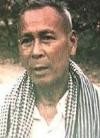Atrocity theme park? Cambodia's "genocide trail" attracting tourists -- and criticism

By DENIS D. GRAY
Associated Press Writer
ANLONG VENG, Cambodia -- Call it crass, macabre or educational, but Pol Pot's shabby grave and a towering stack of his victims' skulls are drawing a growing number of visitors to Cambodia's genocide trail.
These and other relics of the Khmer Rouge reign of terror are the grim counterpoint to Angkor Wat, Cambodia's world-famous ancient temple. Some decry it as "dark tourism" and "a Khmer Rouge theme park," while officials and private entrepreneurs argue that it will reap tourist dollars for an impoverished nation.
The latest station on the circuit is Anlong Veng, the final stronghold of the Khmer Rouge and its leader, Pol Pot, who turned the country into a vast slave labor camp in which as many as 2 million of their fellow Cambodians perished from disease, starvation and relentless executions in the mid-1970s.
"Cambodia is known to the world for two things -- Angkor Wat and the 'killing fields.' Some believe one came from God and the other from hell," says Youk Chhang, a leading researcher of Khmer Rouge atrocities.
This scruffy town in northwest Cambodia once housed one of the 20th century's largest assemblages of mass killers. Now, following up on a government order to preserve Khmer Rouge sites, officials are planning to restore nearly 40 houses of former Khmer Rouge leaders and build a museum where the guides are ex-soldiers of the ultra-communist movement.
"Pol Pot was cremated here. Please help to preserve this historical site," says a Ministry of Tourism sign next to a dirt mound bordered by half-buried soda bottles and protected by a rusting iron roof. The hut where Pol Pot died in 1998, the movement collapsing around him, has disappeared.
Thirty meters away, bulldozers are laying the foundations for a South Korean-built resort with swimming pool. And just down the road, a casino and massive market will cater to visitors from neighboring Thailand.
Youk Chhang, who heads The Documentation Center of Cambodia, is concerned that sites such as Anlong Veng will lose their raw, powerful authenticity.
"We don't want them turned into Disneylands and seen merely as a source of money," he says.
A private Japanese enterprise, JC Royal Co., last year won the concession to develop Choeung Ek, the vast killing ground, into a more tourist-friendly place, while the World Bank is completing a wide, paved road to speed tourist buses to the site 17 kilometers (10 miles) south of Phnom Penh.
At Tuol Sleng, the notorious torture and interrogation center in the capital, some of the desperate prisoner graffiti has been painted over and Youk Chhang had to dissuade the director from giving all the starkly drab buildings a whitewash. He said the director told him: "Don't worry, brother, they will look old again after two or three years."
A harsh critic is former King Norodom Sihanouk who last month objected to genocide memorials which displayed victims' skulls and bones, saying this was done "for the pleasure of tourists." He said it did nothing for the "wandering souls" of those killed and urged that their bones be cremated according to Buddhist custom.
Tuol Sleng and Choeung Ek, which charge a US$2 entry fee, are on the itineraries of almost every tour company and are expected to be visited by many of the 1.6 million foreign tourists expected in Cambodia this year. Even more interest may be generated next year when the surviving Khmer Rouge leaders go on trial for genocidal crimes before a long-delayed, U.N.-backed tribunal.
Youk Chhang's U.S.-funded center, which is delivering boxes of documents on Khmer Rouge atrocities to the tribunal, plans a museum. One of its staffers, Sayana Ser, has toured Nazi concentration camps, other Holocaust sites and Berlin's Jewish Museum while attending a graduate program at Wageningen University in The Netherlands.
Roberto Rossano, a 22-year-old Londoner, said he knew little about the Khmer Rouge nightmare until he visited Choeung Ek.
"When somebody tells you one or two million were killed it's just a number, but when I came and saw just a fraction of what they did -- these skulls -- it absolutely shocks you," he said.
He and a friend had just seen the soaring stupa, or Buddhist reliquary, crammed with 8,985 skulls, some bearing clear evidence of death by hammers, hoes, bamboo sticks and bullets. Skeletal remains and ragged clothes lay in surrounding shallow graves. A sign next to a tree explained how executioners bashed the heads of children against its trunk.
The victims were bused in from Tuol Sleng, a former high school where up to 16,000 suffered torture and abysmal living conditions before being "smashed." Also on display are instruments of torture and scores of haunting photographs of those about to die, taken by their captors.
In the bougainvillea-shaded courtyard are tombs of 14 prisoners killed just before Vietnamese troops captured Phnom Penh in 1979, driving the Khmer Rouge into the jungles to fight as guerrillas and eventually to be squeezed into enclaves like Anlong Veng.
Anlong Veng, only recently cleared of mines, is perhaps the only "living museum" of the horror. Many of its 26,000 inhabitants are Pol Pot's former fighters and officials, some of them missing limbs.
Ta Mok, a brutal military commander, lived here until his death last month. Although he was to have stood trial for atrocities, he was a hero in Anlong Veng, and people eagerly point out his humanitarian legacy -- schools, clinics, a dam, a sawmill that provided free wood to the poor.
"The people all love Ta Mok," says his nephew, Cheam Ponlok.
The commander whom the Western media dubbed "the Butcher" was seen off by hundreds of mourners and chanting Buddhist monks, and his ashes placed in a tomb in a temple _ the newest addition to Cambodia's genocide trail.


0 Comments:
Post a Comment
<< Home